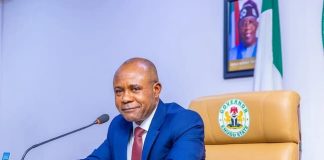The Federal Government spent a total of N3.49tn on domestic debt servicing and payment between January 2015 and September 2017, investigation has shown.
In the same period, the country paid a total of $1.07bn (about N326.69bn) to service foreign loans obtained by both the federal and state governments.
According to the report, it shows the wide gap between the size of domestic borrowing and foreign borrowing, which has seen the government spending much of its revenues, especially during the just exited recession, on debt servicing.
Statistics obtained from the Debt Management Office showed that between October 2015 and September 2017, the Federal Government paid out N2.67tn to service local debts.
Breaking the debt servicing payment down, the Federal Government paid a total of N1.02tn for local debt in 2015. This grew to N1.23tn in 2016.
For the first nine months of 2017, the debt servicing payment had already exceeded the amount for 2016 as the Federal Government had committed N1.24tn to local debt servicing.
Most of the payments were for interests incurred on the funds borrowed monthly by the Federal Government using the instrument of the FGN bonds.
In 2016, for instance, the interest paid on the FGN bonds amounted to N839.17bn. In the same period, the interest on Nigeria Treasury bills added up to N335.58bn, while the interest paid on Treasury bonds amounted to N28.99bn. A total principal of N25bn was paid for Treasury bonds.
Similarly, in the third quarter of 2017, interest payment on the FGN bonds accounted for N377.29bn, while that on NTBs amounted to N143.84bn. On Treasury bonds, N9.38bn was paid, while N159.61m was paid on the new instrument, savings bonds.
The huge debt payment is a reflection of both the high interests on local debts and the size of the Federal Government’s domestic debt in comparison to foreign debt.
September 30 this year, the country’s domestic debt stood at N15.68tn.
As of two years ago, the external loan component of the country’s total debt stock stood at N2.09tn. However, as of September 30, 2017, the external debt component stood at N4.60tn. This means that it rose by N2.6tn or 124.4 per cent.
The domestic debt component of the total debt, on the other hand, rose from N10.27tn as of September 2015 to N15.68tn as of September 2017.
This means that within the two-year period, the domestic debt component had risen by N5.41tn. In percentage terms, the domestic debt rose by 52.68.
Although the external debt component of the total indebtedness increased by a higher proportion, the debt statistics as of September this year showed that the domestic debt, with its high cost of servicing, still dominated the country’s borrowing pattern.
While experts believe that the nation’s total debt is low at about 19 per cent of the Gross Domestic Product, the opinion is different when the ratio of debt servicing is compared to revenue generation. The ratio is put at about 60 per cent for 2016, and this has raised questions on the country’s debt sustainability.
The recent growth in the external debt component reflects the Federal Government’s move to take more foreign loans as against the acquisition of more costly internal loans.
According to the DMO, the current plan to raise $5.5bn from the external debt market will save the country N166bn if it should borrow the same amount of money from the local debt market.
According to the Director-General, DMO, Patience Oniha, the plan is to increase the ratio of the country’s external borrowing to 40 per cent and reduce the size of domestic borrowing to 60 per cent.
At the moment, the ratio stands at 76.96 per cent for local debt and 23.04 per cent for external debt.
For experts, the plan to raise the country’s external borrowing and curtail domestic borrowing is in order.
However, they warn that such borrowings should be tied to productive ventures that have the capacity to yield profits that will be able to absorb interest payment. They also say that it is important to avoid a future foreign debt overhang.
A former President of the Nigerian Economic Society and Executive Director, African Centre for Shared Development Capacity Building, Prof. Olu Ajakaiye, believes that external borrowing is good but says that pitfalls must be avoided.
Ajakaiye stated, “Shifting to what is today low-cost borrowing, we need to ensure that the funds are applied to generate not only naira, but also foreign currencies. The future challenge and risk of external borrowing should not be ignored.
“We need to make sure that external borrowing does not put Nigeria in a foreign exchange overhang in the next 10 to 15 years. There is the need to invest the proceeds from the borrowing on infrastructure and export processing zones.”
Similarly, an associate professor and Head of the Department of Banking and Finance, Nasarawa State University, Uche Uwaleke, said that external borrowing comes with exchange rate risks.
“We should not take short foreign loans; and we should tie any loan we take to projects as we did with the Sukuk bond. It should not just be any project but projects that have the capacity to pay back the money,” he stated.
Uwaleke added that the watchword should be self-liquidating loans.













